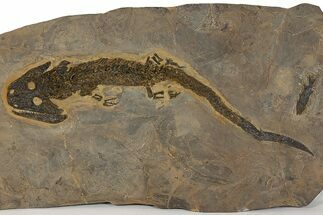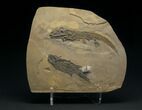This Specimen has been sold.
Spectacular Permian Amphibian & Fish Plate
The fossil beds of Pfalz in south-western Germany have yielded many spectacular Permian fossils for decades, but the location is now closed to collecting - making such specimens increasingly rare on the market. This piece was collected and prepared by a notable German geologist from the area, back in the early 1980's. The Rotliegendes series of mud and siltstones was renowned for its abundant fish and amphibian fossils and this stunning assemblage is a perfect representation of aquatic life that thrived in the area 285 million years ago.
Two complete specimens are present on the plate, including a lateral presentation of the predatory amphibian, Sclerocephalus, and a large, complete paleoniscoid fish, Paramblypterus sp. This group of ancient fish first appeared in the late Silurian, and died out in the Cretaceous.
Sclerocephalus was one of the apex predators of the Permian swamps and these amphibians could attain lengths of 6 feet, but the vast majority of fossils are less than foot long. This amphibian is 12” along a slight curve and the fish is 8.25” in length. Each fossil is nicely preserved with good detail and contrast on an attractive silt stone matrix of swirling pale gray and tan colors.
Fossils from this formation were particularly difficult to extract and typically came out fractured in thin, brittle shards. As was the standard practice, fragmented plates were removed in sections and composited and/or reconstructed on a fiberglass backing for stability. Fossils were then coated with a clear sealer to protect the delicate bones from flaking off. This specimen was composited from fossils found within the same layer and in very close proximity to one another. It has limited enhancement, mostly on the tip of the Scelocephalus tail. The entire back of the slab has been reinforced with fiberglass. This is a very displayable fossil of ancient aquatic life and the rounded plate measures 19 x 14 inches.
Two complete specimens are present on the plate, including a lateral presentation of the predatory amphibian, Sclerocephalus, and a large, complete paleoniscoid fish, Paramblypterus sp. This group of ancient fish first appeared in the late Silurian, and died out in the Cretaceous.
Sclerocephalus was one of the apex predators of the Permian swamps and these amphibians could attain lengths of 6 feet, but the vast majority of fossils are less than foot long. This amphibian is 12” along a slight curve and the fish is 8.25” in length. Each fossil is nicely preserved with good detail and contrast on an attractive silt stone matrix of swirling pale gray and tan colors.
Fossils from this formation were particularly difficult to extract and typically came out fractured in thin, brittle shards. As was the standard practice, fragmented plates were removed in sections and composited and/or reconstructed on a fiberglass backing for stability. Fossils were then coated with a clear sealer to protect the delicate bones from flaking off. This specimen was composited from fossils found within the same layer and in very close proximity to one another. It has limited enhancement, mostly on the tip of the Scelocephalus tail. The entire back of the slab has been reinforced with fiberglass. This is a very displayable fossil of ancient aquatic life and the rounded plate measures 19 x 14 inches.
SPECIES
Sclerocephalus hauseri & Paramblypterus sp.
LOCATION
Pfalz, Germany
SIZE
Amphibian 12” along curve, Fish 8.25”
CATEGORY
ITEM
#7081
We guarantee the authenticity of all of our specimens.
 Reviews
Reviews















